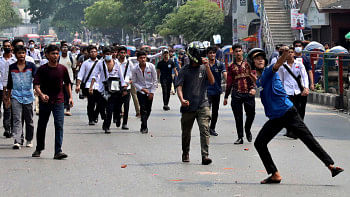Pannalal Ghosh's birth centenary

Clockwise (from top-left): Pandit V.G. Karnad (2-R); Tulika Ghosh; grande flautists Tawquir Rashaad Nawaz (left) and Tawfique Nawaz; Pandit Dhrubo Ghosh perform at the event. Photo: Golam Mahbub
Marking 100th birth anniversary of the legendary grande flautist Pannalal Ghosh, a three-day celebration programme was held (ending on July 31) at the main auditorium of Bangladesh National Museum, Dhaka.
The inventor (1938) of the grande flute (long bansuri) Ghosh was born in Barisal, on July 31 in 1911. Ghosh has disciples, grand-disciples and great grand-disciples all over the subcontinent who are performers and aspirants playing the music he had set forth. His fold brought together the music of the Sur Samrat Alauddin Khan; the Beenkar Dabir Khan of the Senia heritage; the DagarVani, a purist and authentic art -- the influence of many great maestros.
From Dhrupad-styled khayal to the simple bhatiali, he embraced all forms of music. Ghosh married the mystique of the folk flute to the high art that's classical music.
Jointly hosted by the ARK Foundation and the Great Heritage Trust, the three-day event featured grande flute, sarangi and classical vocal performances.
Chairman of ARK Foundation and Minister of Foreign Affairs, Dr. Dipu Moni presented short profiles of the featured artistes while emceeing the event.
Alongside grande flautists, the celebration also included vocal renditions of khayal, thumri, dadra and kajri. On the first day (July 29), Ruchira Panda presented classical vocal music while Pandit Nityanand Haldipur, a disciple of Pannalal Ghosh, played the grande flute.
Tulika Ghosh, Pannalal's niece, started off the second day's (July 30) soiree by performing Raga Marwa, her late uncle's favourite. Bangladeshi tabla artiste Swarup Hossain accompanied her on during the rendition on vilambit ektaal and drut teentaal. The artiste's rendition zeroed in on knowledge and meditation.
The bandish “Guru Bina Gaye Dhyan Bhangmey” was superb. A composition by Pandit Gyan Prokash Ghosh followed. Tulika later performed Raga Deepabali, created by Pannalal Ghosh, while Swarup played madhya laya teentaal on tabla. With the bandish “Aayi Shraban Ki Bahar”, Tulika, daughter of internationally acclaimed tabla maestro Padma Bhushan Pandit Nikhil Ghosh, wrapped up her performance with a kajri. Swarup Hossain played kaharba along with the rhythmic melody.
Sarangi maestro Pandit Dhrubo Ghosh was next to take the stage. Dhrubo Ghosh is one of the leading sarangi artistes in north India. He has taken sarangi performance to new heights. Not just that, he has made remarkable innovations -- introducing sarangi with four and five strings, expanding the range of expression.
The maestro first performed Raga Barawa. Bangladeshi tabla artiste Pinu Sen Das accompanied him during the rendition on madhya laya and drut teentaal. Raga Jog was his next performance. Bangladeshi classical artiste Leo J. Baroi accompanied several featured artistes on tanpura on the three consecutive days.
Grande flautists Tawfique Nawaz and Tawquir Rashaad Nawaz kicked off the concluding day's (July 31) programme, performing alaap on Raga Adbhut Durga. Alaap is, perhaps, the most evolved and complete form of Indian classical music. It employs high technique and lends itself admirably to aesthetic expression, meditation and creativity. To render it beautifully is the dream of every great classical vocalist. The hallmark of alaap combines its majesty, simplicity and authenticity underpinned by a highly structured format. The duo's second performance belonged to the same genre, on Raga Nupurdhwani that Ghosh created when his daughter died of pox at the age of ten.
A direct disciple of Ghosh, Pandit V.G. Karnad was the last performer of the soiree. The south Indian (Karnataka) artiste first played Raga Hansadhwani that was followed by Raga Yaman, which he learned first from his guru, Pannalal Ghosh. Karnad's next performance featured a monsoon themed Raga Mian Ki Malhar. Swarup Hossain accompanied the 86-year-old artiste. The Pandit's overwhelming devotion at his advanced age was inspiring.
The artiste also performed Raga Bhatiali on kaharba, and a dadra set on the romantic morning Raga Bhairabi that wrapped up the soiree. Dr. Vishvas Kulkarni, a senior scientific officer at Bhabha Atomic Research Centre of Mumbai, accompanied Panditji on grande flute.
The celebration highlighted the 'Guru-Shishya parampara' stretching over five generations throughout the subcontinent.

 For all latest news, follow The Daily Star's Google News channel.
For all latest news, follow The Daily Star's Google News channel. 



Comments